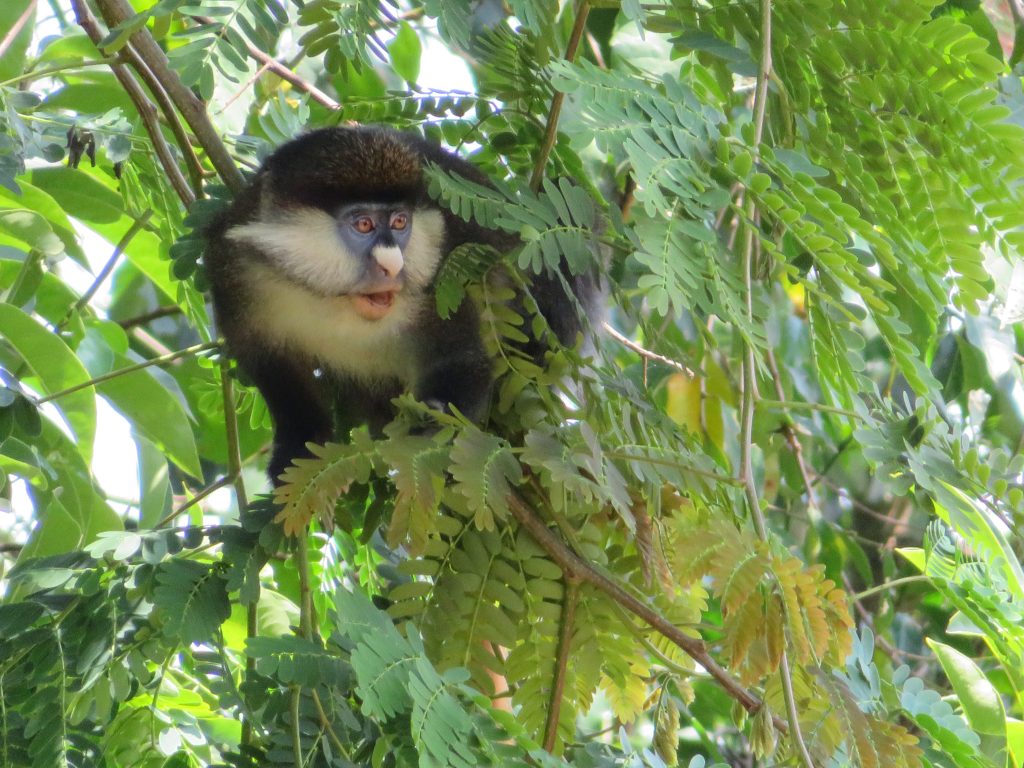
Accommodation and facilities at Nkima Forest Lodge
The main lodge area has a bar, lounge and dining area with comfortable seating. During the day, this can be opened up on three sides to allow a cool breeze and views of the grassy glade surrounded by forest.


Nkima Forest Lodge has four double (or twin) ensuite rooms and two family cottages (with two separate rooms and a shared bathroom). The rooms are situated separately with their own private deck in the forest and have natural lighting and views into the canopy. Hot water is provided by solar heaters; there are solar-powered lights and charging sockets for phones/laptops, etc.



Near the lounge area, the lodge has a high deck built into the forest, with views across the Mabamba wetlands, perfect for an evening sundowner or a quiet spot for sitting and reading in the shade.

A short distance from the main lodge there is a fire pit with sunset views over the forest canopy and the wetlands beyond. Through a small patch of forest beyond the fire pit – and hidden from the main lodge – there is a swimming pool with a protected shallow area for children and a small deck with chairs and loungers. There are hammocks at various spots for resting or reading in the cool of the forest.

The lodge offers freshly cooked food with a limited but changing menu and caters for all dietary requirements. The chefs have been trained by the owners who take a personal interest in the quality of the food.
The flora and fauna of Nkima Forest Lodge
The forest has numerous bird species, as well as Red-tailed monkeys (after which the lodge is named) and Vervet monkeys. The site also has many species of butterflies and insects, as well as smaller mammals such as squirrels, mongoose, and bushbabies. Bushbucks and duiker have occasionally been spotted.
Nkima Forest Lodge was started to preserve this small patch of indigenous forest (27 acres), which is termed a semi-evergreen Guineo-Congolian rainforest. This means it is on the edge of a vast vegetation zone and contains many tree species from West Africa. Although most of the big trees were logged about 30 years ago (many coppice well), enough seeds and saplings re-grew to provide a diverse secondary forest with more than 20 characteristic forest species as well as many forest edge species. This diversity means that at any time of the year there will be a fruiting tree, which is vital for the fructivorous red- tailed monkeys (Nkima). There are plenty of leaves to feed the caterpillars, which leads to a great diversity of butterflies. Lake flies hatch all at once and can be found in vast numbers at certain moon phases. All this insect life is fantastic for the birds, frogs and lizards which abound in the forest.
Forest creatures are used to hiding in the shadows but if you sit quietly on your deck you are bound to see some interesting wildlife. We have plenty of guide books or please ask for more information. There are several species lists in the lounge, which you are welcome to add to.
Activities at Nkima Forest Lodge
Mabamba Wetlands Shoebill-watching tours and boat trips

One of the main reasons for coming to Nkima Forest Lodge is to see the rare Shoebill Stork in its natural wetlands environment. The local community organise boat tours with expert guides to see the Shoebill as well as other wetland bird species. These trips are popular with birders and non-birders, and give a unique opportunity to experience the natural wetlands environment. By staying at the lodge you will be able to arrive at the Mabamba landing site in the early morning, the best time for seeing the Shoebill and other birdlife.
The community has worked hard for several years to protect Mabamba Swamp. There are many boats that travel to Bussi Island and provide guided tours to see the Shoebill. The local boats can supply life jackets if requested and we have some lifejackets for children. We have contacts for good local guides.
If you wish to use less fuel, or are just tired of sitting in the car, you can walk or cycle to the landing site, from where you take a community boat to see the magnificent Shoebill stork at Mabamba Bay. The local council of Kasanje has recently imposed a tax on people visiting the Shoebill: 25,000 ugx for a foreigner; 15,000 ugx for a resident and 10,000 ugx for Ugandans. Please insist on a receipt as the funds go towards community development and conservation of the swamp. The price to hire a boat is about 100,000 UGX (40,000 for the boat and 60,000 for the guide). If you wish to spend more than 1.5 hours to 2 hours in the swamp than it will cost an additional 50,000 UGX an hour. This includes a boatman and guide fees.
Bird watching
Over 140 species of birds have been seen from the lodge and we maintain a bird list for visitors. Non-birders will enjoy the noisy large black and white casqued hornbills, western banded snake eagles, the Great Blue Turacos, African grey parrots and the Pied hornbills. Specialist birders can look out for the White spotted flufftail, the Vanga flycatcher, the whistling cisticola, the Snowy-headed robinchat, the Western nicator and the red-bellied paradise flycatcher. The owner is knowledgeable about the area’s birdlife and we can arrange specialist bird guides on request.
Walks
There are a number of short and longer walks directly from the lodge. The perimeter walk around our 27 acre forest includes a visit to an old fig tree, of spiritual significance to the Mabamba clan, one of the many clans that make up the Baganda, the largest ethnic group in Uganda. This walk takes about 30-40 minutes.

There is a short walk along the top of the hill, which leads to a viewpoint with great views of the Mabamba Wetlands to the west, Bussi Island to the south and Entebbe to the east. Longer walks can be arranged to Mabamba village and along the forested edge of the wetlands below the lodge. We offer guided walks for residents on request.
Cycling and bike hire
We have six mountain bikes for guests to hire. These cost $20 for half a day. There are numerous cycling routes around the lodge: a short circuit below the hill, or towards Kasanje through the nearby villages. For a longer bike ride, we recommend Bussi Island, which has excellent tracks for cycling and very few vehicles. To reach Bussi Island, you have to put your bike on a local boat which will ferry you to the island (10,000 per person return). You are welcome to ride on your own or we can organise a guide for you.
Canoes
We have two canoes available for hire for paddling along the channels in the wetlands.
Shoebill Adventure Park
This attraction on Bussi Island can be reached by boat from the Mabamba landing site (or by boat and cycling). The park offers an aerial rope adventure challenge with 3 levels of difficulty all ending in a zip line down to a sandy beach.
Games
The lodge has a large selection of board and card games available for residents as well as croquet and boules/bocce.
Butterfly catching
Children love to try their skills at catching and identifying the many butterflies on the hill with small nets provided by the lodge. The butterflies are of course released after identification.
Our ecological footprint
Nkima Forest Lodge is completely off-grid and all the electrical power comes from solar panels. Sockets in the rooms can be used to charge phones or laptops.
The hot water is also heated by solar and is usually warm enough – even on a dull or rainy day – as we have a large insulated storage tank. Water comes from a deep borehole and has been tested as potable, and is far better than using water from plastic water bottles. Water is pumped up the hill with a solar pump and the swimming pool pump is also solar. The laundry is done by hand and sun dried! Hopefully you can see that it is possible to enjoy a modern life without too big an impact on the environment.
We use gas to cook on but also use a pressure cooker to reduce gas consumption. Most food is locally sourced and freshly prepared.
About Baganda culture, clans and totems
We are located in Busiro county in central Uganda where the Baganda are the predominant ethnic group. The Baganda can be divided into 56 clans who share a common ancestry and are headed by the king or Kabaka. Each clan has a sacred totem and this hill is sacred to the Mamba clan. The Mamba totem is a lungfish. The clan totem is protected and cannot be hunted. This probably explains why the Shoebill Storks are found here, because they DO eat lungfish.
Nansubuga, the name of this hill, is a favourite Mamba clan name for a girl.
The Baganda traditional beliefs are similar to the ancient Greeks and have many myths, heroes and 73 super-human god-like men called Balubaale. These include Musoke, god of the rainbow and Mukasa, god of Lake Victoria. Like Zeus, Katonda is chief of the Balubaale. There are natural shrines all over Buganda dedicated to particular balubaale. Mizimu are spirits of dead people and these spirits can haunt people particularly if they have been wronged. Sometimes these spirits enter a natural object like a tree, rock or river. This object is called a MISAMBWA. We have a particularly spectacular MISAMBWA, in the shape of a fig tree, below our forest.
How to find Nkima Forest Lodge
Making an enquiry? If you call any businesses listed in this Travel Directory, please mention Diary of a Muzungu sent you.








